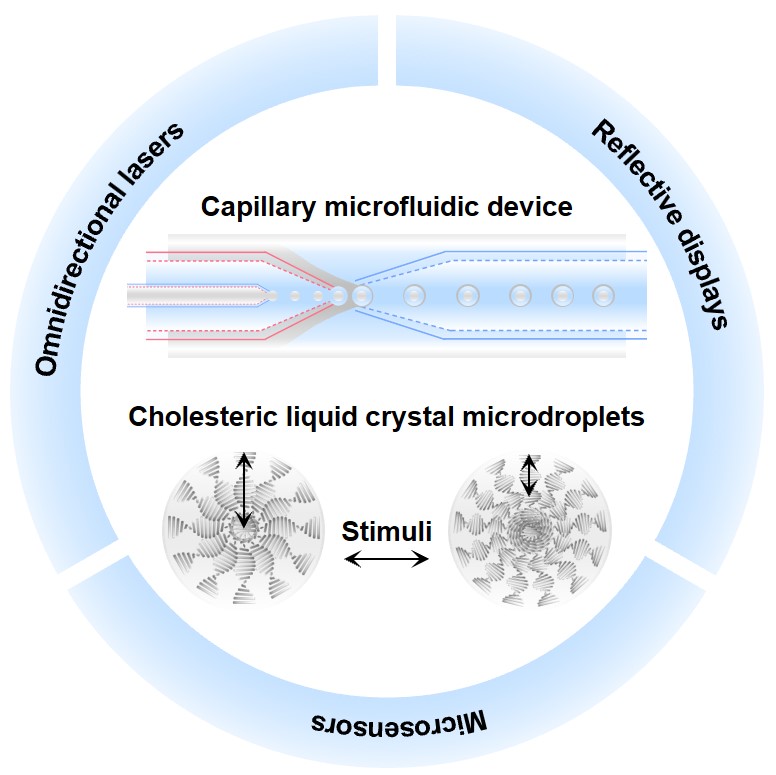Search
Title: Dynamic Manipulation of Photonic Bandgaps in Cholesteric Liquid Crystal Microdroplets for Applications
Author: Xiaojun Liu, Lang Qin*, Yanlei Yu
Journal: Acta Phys. -Chim. Sin., 2024, 40, 2305018. doi: 10.3866/PKU.WHXB202305018
Abstract:
Cholesteric liquid crystal (CLC) microdroplets, as three-dimensional photonic crystals, exhibit high spatial symmetry. In these microdroplets, LC molecules are aligned parallel to the surface of the spherical geometry, while the helical axes are radially oriented. This symmetrical helical superstructure arrangement forms a Bragg-onion structure within the CLC microdroplets, resulting in selective reflection of a specific wavelength in all directions. Due to their unique angle-independent photonic bandgap (reflection wavelength), CLC microdroplets have emerged as promising optical materials for applications such as omnidirectional lasers, reflective displays, and microsensors. Recently, there has been growing interest in capillary microfluidic technologies, which allow the fabrication of monodisperse and complex CLC microdroplets with regular molecular alignment in a continuous, controllable, and high-throughput manner. This review primarily focuses on CLC microdroplets fabricated using capillary microfluidic technologies. Firstly, the characteristics of capillary microfluidic technology are outlined, along with three important parameters for fabricating CLC microdroplets: inertial, viscous, and interfacial forces. Capillary microfluidic devices typically consist of hydrophilic or hydrophobic tapered capillaries inserted into a square capillary. The principle of immiscible liquids is utilized to select suitable solution systems. By designing the device structures and choosing appropriate solution systems, single, double, triple, and even multiple CLC microdroplets can be fabricated. Secondly, the optical properties of CLCs confined in spherical geometries are discussed. CLC self-organizes into ordered helical superstructures while maintaining fluidity, leading to symmetrical pitch lengths in CLC microdroplets that respond to stimuli. The mechanisms and strategies for tuning the structural colors of CLC microdroplets under varying temperatures, solvents, and light conditions are demonstrated. Additionally, the unique photonic cross-communication between closely packed, monodisperse CLC microdroplets is explained in the context of single, double, or opposite-handedness helical superstructures in CLCs. Furthermore, the review reports on the current and prospective applications of CLC microdroplets in omnidirectional lasers, reflective displays, and microsensors. Various methods for inducing lasing in CLC microdroplets are presented, including distributed feedback resonators, Bragg reflection resonators, and whispering gallery modes. Flexible reflection labels and security labels are generated by incorporating different materials in each layer of the microdroplets or by leveraging the unclonable photonic cross-communication micropatterns observed in hexagonally close-packed CLC microdroplets. The responsive pitch lengths and molecular alignments of CLC microdroplets also make them suitable candidates for colorimetric reporters and optical biosensors. Finally, the review briefly discusses the existing challenges and opportunities in the field of CLC microdroplets, offering a forecast for future developments.
Fulltext Link: https://www.whxb.pku.edu.cn/EN/10.3866/PKU.WHXB202305018








